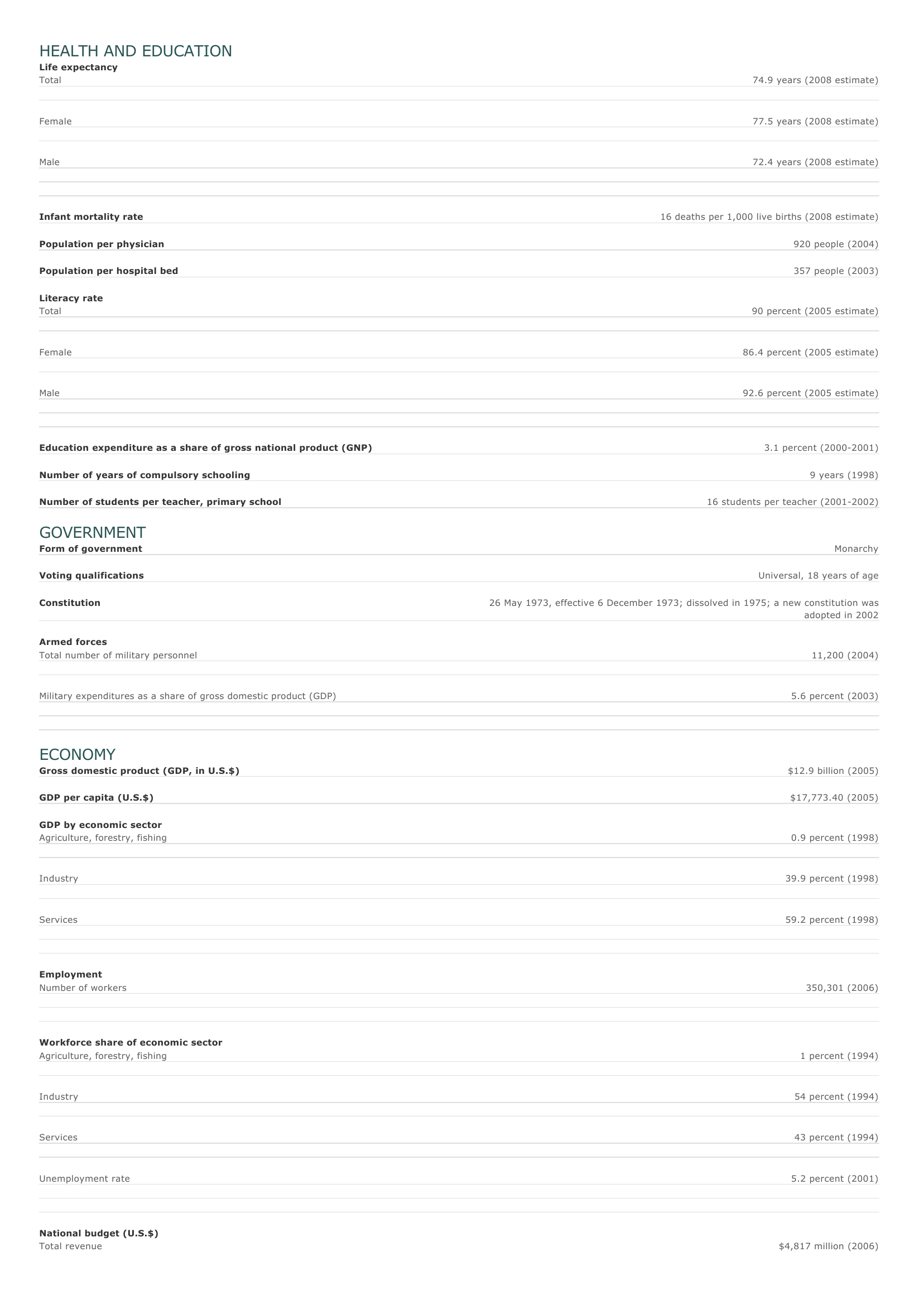Bahrain Facts and Figures. BASIC FACTS Official name Capital Area Kingdom of Bahrain Manama 707 sq km 273 sq mi PEOPLE Population 718,306 (2008 estimate) Population growth Population growth rate 1.34 percent (2008 estimate) Projected population in 2025 865,890 (2025 estimate) Projected population in 2050 973,412 (2050 estimate) Population density 1,080 persons per sq km (2008 estimate) 2,798 persons per sq mi (2008 estimate) Urban/rural distribution Share urban 90 percent (2003 estimate) Share rural 10 percent (2003 estimate) Largest cities, with population Manama 139,000 (2003) Ar Rif?' al Gharb? 79,986 (2001) Al Mu?arraq 56,000 (2001) Mad ?nat '? sá 36,833 (2001) Ethnic groups Bahraini Arab 63 percent Asian 13 percent Other Arab 10 percent Iranian 8 percent O ther 6 percent Languages Arabic (official), English, Persian (Farsi), Urdu Religious affiliations Shiite Muslim 60 percent Sunni Muslim 25 percent Christian 9 percent O ther 6 percent HEALTH AND EDUCATION Life expectancy Total 74.9 years (2008 estimate) Female 77.5 years (2008 estimate) Male 72.4 years (2008 estimate) Infant mortality rate 16 deaths per 1,000 live births (2008 estimate) Population per physician 920 people (2004) Population per hospital bed 357 people (2003) Literacy rate Total 90 percent (2005 estimate) Female 86.4 percent (2005 estimate) Male 92.6 percent (2005 estimate) Education expenditure as a share of gross national product (GNP) Number of years of compulsory schooling Number of students per teacher, primary school 3.1 percent (2000-2001) 9 years (1998) 16 students per teacher (2001-2002) GOVERNMENT Form of government Monarchy Voting qualifications Universal, 18 years of age Constitution Armed forces Total number of military personnel Military expenditures as a share of gross domestic product (GDP) 26 May 1973, effective 6 December 1973; dissolved in 1975; a new constitution was adopted in 2002 11,200 (2004) 5.6 percent (2003) ECONOMY Gross domestic product (GDP, in U.S.$) $12.9 billion (2005) GDP per capita (U.S.$) $17,773.40 (2005) GDP by economic sector Agriculture, forestry, fishing 0.9 percent (1998) I ndustry 39.9 percent (1998) Services 59.2 percent (1998) Employment Number of workers Workforce share of economic sector Agriculture, forestry, fishing 350,301 (2006) 1 percent (1994) I ndustry 54 percent (1994) Services 43 percent (1994) Unemployment rate National budget (U.S.$) Total revenue 5.2 percent (2001) $4,817 million (2006) Total expenditure $3,609 million (2006) Monetary unit 1 Bahraini dinar (BD), consisting of 1,000 fils Major trade partners for exports United States, India, Saudi Arabia, United Arab Emirates, Japan Major trade partners for imports Saudi Arabia, United States, Japan, Germany, United Kingdom ENERGY, COMMUNICATIONS, AND TRANSPORTATION Electricity production Electricity from thermal sources 100 percent (2003 estimate) Electricity from hydroelectric sources 0 percent (2003 estimate) Electricity from nuclear sources 0 percent (2003 estimate) Electricity from geothermal, solar, and wind sources 0 percent (2003 estimate) Number of radios per 1,000 people 82 (2000 estimate) Number of telephones per 1,000 people 271 (2005) Number of televisions per 1,000 people 429 (2000 estimate) Number of Internet hosts per 10,000 people 19 (2003) Daily newspaper circulation per 1,000 people 117 (1996) Number of motor vehicles per 1,000 people 378 (2003) Paved road as a share of total roads 79 percent (2003) SOURCES Basic Facts and People sections Area data are from the statistical bureaus of individual countries. Population, population growth rate, and population projections are from the United States Census Bureau, International Programs Center, International Data Base (IDB) (www.census.gov). Urban and rural population data are from the Food and Agriculture Organization (FAO) of the United Nations (UN), FAOSTAT database (www.fao.org). Largest cities population data and political divisions data are from the statistical bureaus of individual countries. Ethnic divisions and religion data are largely from the latest Central Intelligence Agency (CIA) World Factbook and from various country censuses and reports. Language data are largely from the Ethnologue, Languages of the World, Summer Institute of Linguistics International (www.sil.org). Health and Education section Life expectancy and infant mortality data are from the United States Census Bureau, International Programs Center, International database (IDB) (www.census.gov). Population per physician and population per hospital bed data are from the World Health Organization (WHO) (www.who.int). Education data are from the United Nations Educational, Scientific and Cultural Organization (UNESCO) database (www.unesco.org). Government section Government, independence, legislature, constitution, highest court, and voting qualifications data are largely from various government Web sites, the latest Europa World Yearbook, and the latest Central Intelligence Agency (CIA) World Factbook. The armed forces data is from Military Balance. Economy section Gross domestic product (GDP), GDP per capita, GDP by economic sectors, employment, and national budget data are from the World Bank database (www.worldbank.org). Monetary unit, agriculture, mining, manufacturing, exports, imports, and major trade partner information is from the statistical bureaus of individual countries, latest Europa World Yearbook, and various United Nations and International Monetary Fund (IMF) publications. Energy, Communication, and Transportation section Electricity information is from the Energy Information Administration (EIA) database (www.eia.doe.gov). Radio, telephone, television, and newspaper information is from the United Nations Educational, Scientific and Cultural Organization (UNESCO) database (www.unesco.org). Internet hosts, motor vehicles, and road data are from the World Bank database (www.worldbank.org). Note Figures may not total 100 percent due to rounding. Microsoft ® Encarta ® 2009. © 1993-2008 Microsoft Corporation. All rights reserved.

































